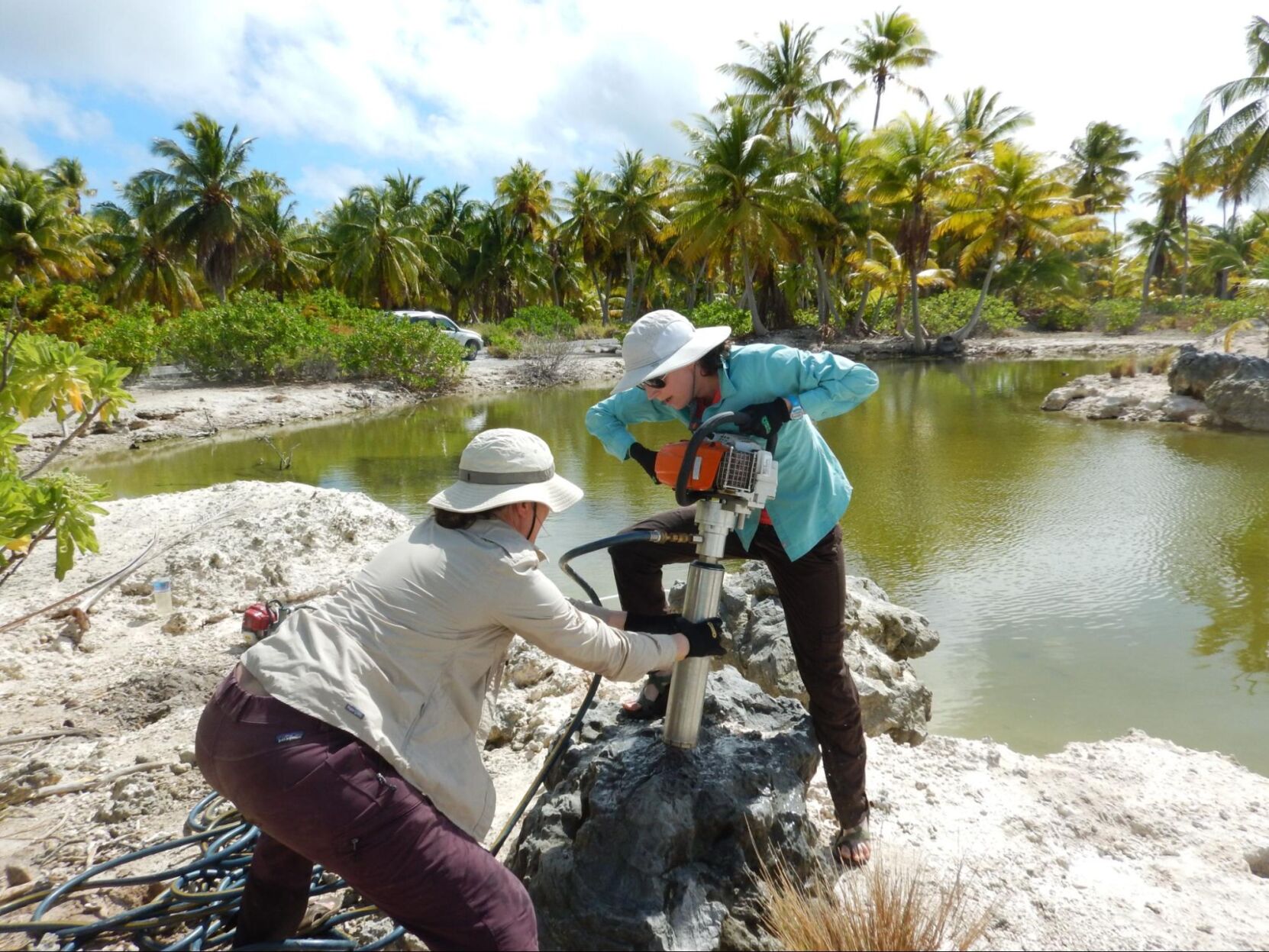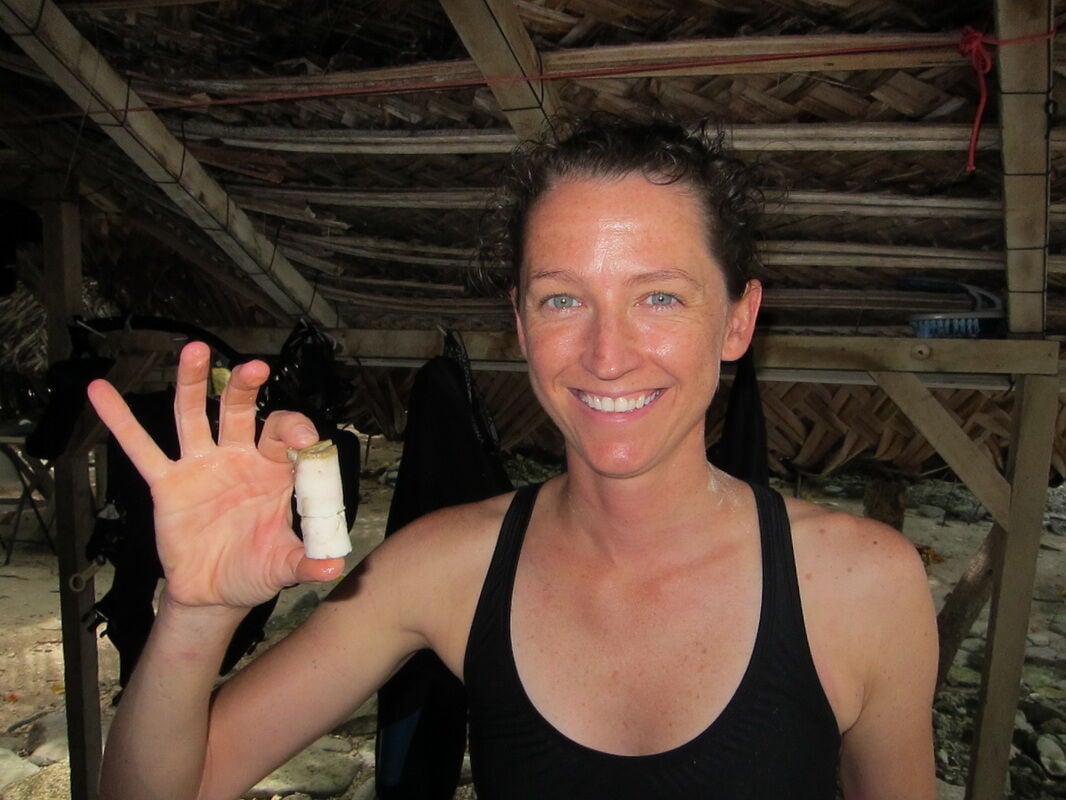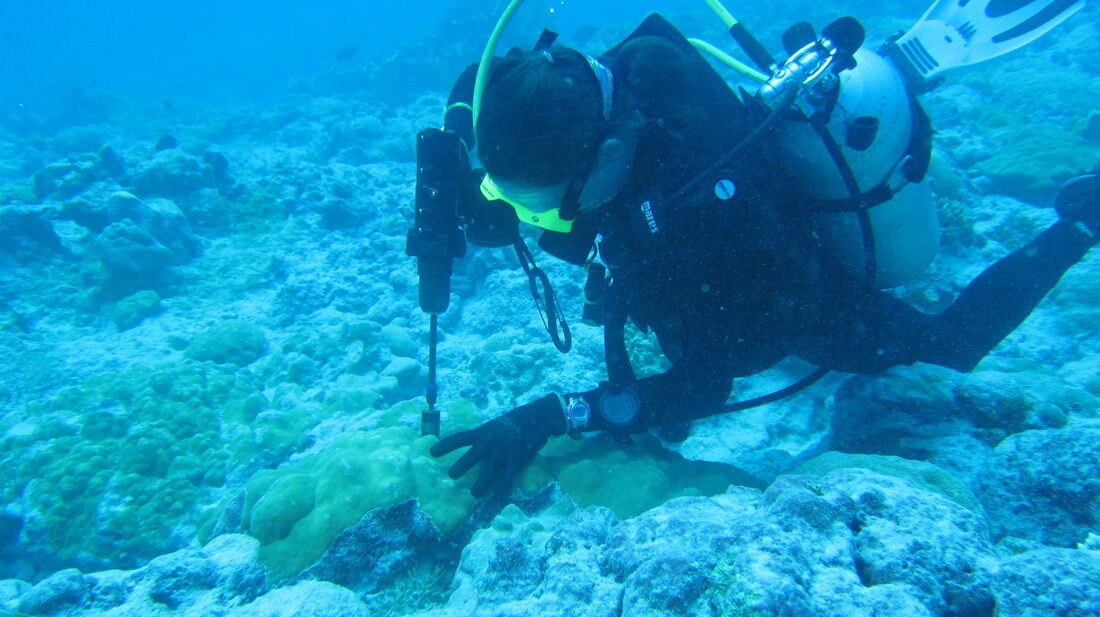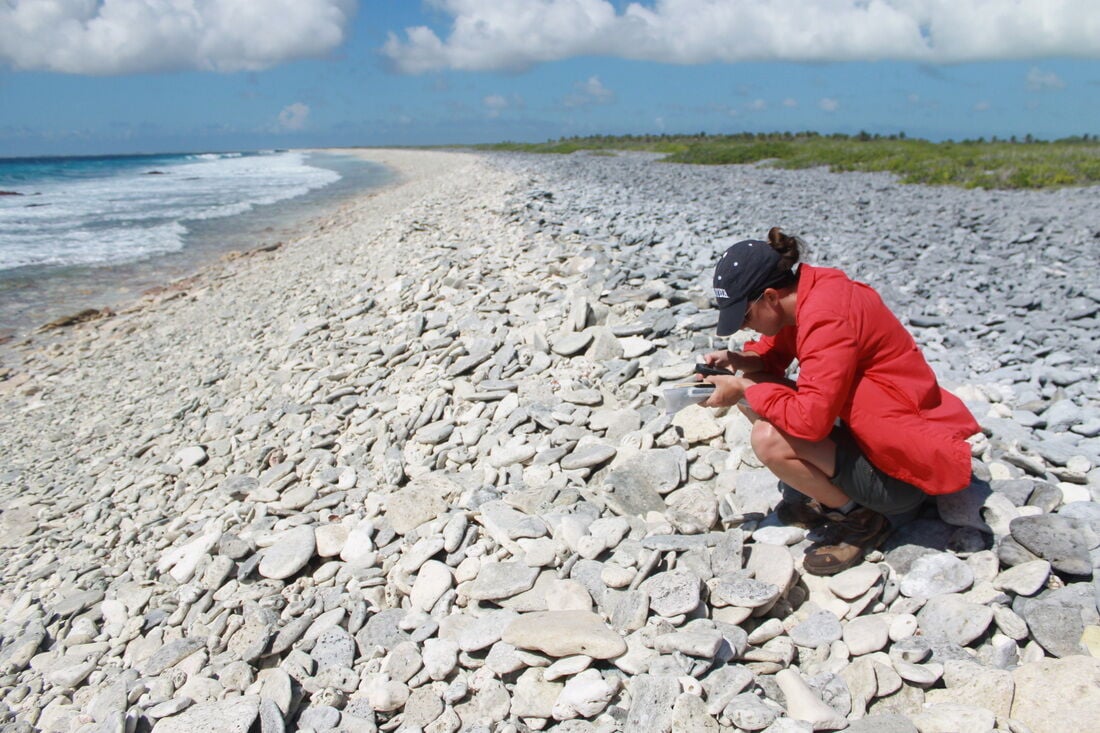Wildfires and extreme weather often get climate change headlines, but Earth’s oceans, often out of view, are catching most of the warming.
Data back to 1854 show that the most recent 10 years have been the oceans’ warmest on record. More recently, another quantum jump has occurred. Daily satellite analyses indicate May 2023 ocean temperatures were the warmest since 1981.

ANDREA MOORE, FLORIDA STATE
Pamela Grothe, an assistant professor at the University of Mary Washington in Fredericksburg, Va., with help from Florida State University assistant professor Alyssa Atwood, drills into 5,000-year-old coral as part of their research in 2018 on Christmas (Kiritimati) Island.
Critically involved is the Pacific. As the largest ocean on Earth, its natural temperature fluctuations interact with the atmosphere to guide global weather patterns. The warmer phase of these fluctuations, called El Niño, has been absent for three years. But in the last couple of months, it has come roaring back.
Pamela Grothe, a climate scientist at the University of Mary Washington in Fredericksburg, Va., is working to understand how much of these El Niño temperature surges are related to the warming climate. To do that, she and her team need to find a way to look much further back in time — much further.
“We had to be creative, and think of novel ways to reconstruct El Niño variability back into pre-industrial times, and corals are perfect little recorders of sea surface temperature.”

One of the few islands that sits in this critical part of the Pacific near the equator is Kiritimati. Also known as Christmas Island, it is about a three-hour flight south from Hawaii.
Grothe and her team have traveled to the island several times to collect samples by drilling cores through corals and taking them back to the lab for analysis.
Two geochemical signatures show up in the samples that match the ocean temperatures. One of them is the ratio of calcium to strontium, the other is the ratio of two different oxygen isotopes.
“One millimeter (in the sample) equates to about one month of coral growth, so that equates to a monthly sea surface temperature. We can plot the temperature record right on top of the geochemistry records, and it is actually really amazing,” she said.
Her work shows a distinctive change in El Niño in the recent decades. “The most recent decades are about 25 percent stronger than the entire pre-industrial record, spanning the last 6,000 years.”
Most of the larger fossilized core samples are between 3,000 and 5,000 years old; those cores can cover several decades and be a yard long. But many gaps in the records remain. Grothe and her team have returned to the island for more samples to fill those gaps, hoping to develop a continuous short-term record going back 200 years by getting multiple smaller cores that provide data over periods of 10 to 20 years.
While on the trip, she and the team will usually have either a land day or a boat day to get the samples they need. A land day can be as straightforward as riding around the island and looking for fossilized corals.

WILLIAM GROTHE PHOTO
Climate scientist Pamela Grothe drilling a mini core from a modern coral reef as part of climate change research in 2018 off Christmas (Kiritimati) Island.
“They look like big beach rocks, but they are really ancient corals,” Grothe said.
But to be sure their analysis of fossilized corals is accurate, they need to calibrate them with corals from the last few decades, when direct ocean temperature records are the best. And that means a boat day.
They will suit up in their diving gear and drill very small cores from the live corals underwater. In an effort to protect the living coral, they only drill a few inches inward. Immediately afterward, they plug the holes with cement, so the corals continue to grow.
“We’re not killing any corals for science,” Grothe said.
A self-described science mom, Grothe emphasized the importance of corals beyond their help with ocean temperature records.
“They host much of the oceans’ biodiversity, including smaller organisms that form the building blocks of the ocean food web,” she said.
Larger organisms feed on the smaller organisms, cascading upward into larger fish, providing a critical food source for people in many parts of the world. Physically, offshore coral reefs break up strong waves as they move from open waters to the shore, helping preserve the coastal environment and infrastructure.

WILLIAM GROTHE PHOTO
Climate scientist Pamela Grothe takes GPS waypoints to identify the site of fossil coral rubble samples while doing research in 2018 on Christmas (Kiritimati) Island.
There is one other thing she hopes to learn more about on her trips.
Knowing that corals thrive within a narrow range of temperatures, and thinking about the future, she is returning to see how resilient corals are. When the water is too warm for too long, they get heat stress — what we see as bleaching.
On a trip in 2013, the corals were colorful and thriving, but when she returned in 2018 after a strong El Niño, the reef had been devastated.
“Reefs take about 10 to 15 years to recover on their own, but if they just keep getting hit by these (strong El Niño) events quicker than they recover, there’s not going to be much hope for these coral reefs.”
While fires and storms may make the short-term headlines, her research is a reminder that in the longer term, what happens in the Pacific does not stay in the Pacific.
-
One scientist drills into the past to figure out ocean warming
David J. Phillip
Diver Everton Simpson carries pieces of staghorn coral from a nursery to be planted inside the White River Fish Sanctuary Monday, Feb. 11, 2019, in Ocho Rios, Jamaica. One day, Simpson and the other Jamaicans doing this work hope, the coral and fish will fully return and match the beauty of the water above. (AP Photo/David J. Phillip)
David J. Phillip
Diver Everton Simpson carries pieces of staghorn coral from a nursery to be planted inside the White River Fish Sanctuary Monday, Feb. 11, 2019, in Ocho Rios, Jamaica. One day, Simpson and the other Jamaicans doing this work hope, the coral and fish will fully return and match the beauty of the water above. (AP Photo/David J. Phillip)
-
One scientist drills into the past to figure out ocean warming
David Goldman
Nicholas Bingham uses an underwater flashlight to spearfish at night, which is banned, under a moonlit sky, in Stewart Town, Jamaica, Friday, Feb. 15, 2019. It's impossible for them to see anything but what's illuminated right in front of them, and the distant lights from land gauge how far out they've swum. (AP Photo/David Goldman)
David Goldman
Nicholas Bingham uses an underwater flashlight to spearfish at night, which is banned, under a moonlit sky, in Stewart Town, Jamaica, Friday, Feb. 15, 2019. It's impossible for them to see anything but what's illuminated right in front of them, and the distant lights from land gauge how far out they've swum. (AP Photo/David Goldman)
-
-
One scientist drills into the past to figure out ocean warming
David J. Phillip
Diver Everton Simpson reaches to tie lines of staghorn coral growing at a coral nursery inside the White River Fish Sanctuary Monday, Feb. 11, 2019, in Ocho Rios, Jamaica. Simpson kicks up some sand as he harvests some of the precious crop to be transplanted in a protected area. The current propels him back and forth, making the delicate process seem akin to trying to thread a needle on a roller coaster. (AP Photo/David J. Phillip)
David J. Phillip
Diver Everton Simpson reaches to tie lines of staghorn coral growing at a coral nursery inside the White River Fish Sanctuary Monday, Feb. 11, 2019, in Ocho Rios, Jamaica. Simpson kicks up some sand as he harvests some of the precious crop to be transplanted in a protected area. The current propels him back and forth, making the delicate process seem akin to trying to thread a needle on a roller coaster. (AP Photo/David J. Phillip)
-
One scientist drills into the past to figure out ocean warming
David J. Phillip
Fish swim past planted staghorn coral inside the the White River Fish Sanctuary Tuesday, Feb. 12, 2019, in Ocho Rios, Jamaica. At White River Fish Sanctuary, which is only about 2 years old, the clearest proof of early success is the return of tropical fish that inhabit the reefs, as well as hungry pelicans, skimming the surface of the water to feed on them. (AP Photo/David J. Phillip)
David J. Phillip
Fish swim past planted staghorn coral inside the the White River Fish Sanctuary Tuesday, Feb. 12, 2019, in Ocho Rios, Jamaica. At White River Fish Sanctuary, which is only about 2 years old, the clearest proof of early success is the return of tropical fish that inhabit the reefs, as well as hungry pelicans, skimming the surface of the water to feed on them. (AP Photo/David J. Phillip)
-
-
One scientist drills into the past to figure out ocean warming
David J. Phillip
Diver Lenford DaCosta cleans up lines of staghorn coral at an underwater coral nursery inside the Oracabessa Fish Sanctuary, Tuesday, Feb. 12, 2019, in Oracabessa, Jamaica. With fish and coral, it's a codependent relationship. The fish rely upon the reef structure to evade danger and lay eggs, and they also eat up the coral's rivals. (AP Photo/David J. Phillip)
David J. Phillip
Diver Lenford DaCosta cleans up lines of staghorn coral at an underwater coral nursery inside the Oracabessa Fish Sanctuary, Tuesday, Feb. 12, 2019, in Oracabessa, Jamaica. With fish and coral, it's a codependent relationship. The fish rely upon the reef structure to evade danger and lay eggs, and they also eat up the coral's rivals. (AP Photo/David J. Phillip)
-
One scientist drills into the past to figure out ocean warming
David J. Phillip
Diver Lenford DaCosta tends to lines of staghorn coral growing at an underwater nursery inside the Oracabessa Fish Sanctuary Tuesday, Feb. 12, 2019, in Oracabessa, Jamaica. On the ocean floor, small coral fragments dangle from suspended ropes, like socks hung on a laundry line. DaCosta and other divers tend to these underwater nurseries much as a terrestrial gardener minds a flower bed, plucking off snails and fireworms that feast on immature coral. (AP Photo/David J. Phillip)
David J. Phillip
Diver Lenford DaCosta tends to lines of staghorn coral growing at an underwater nursery inside the Oracabessa Fish Sanctuary Tuesday, Feb. 12, 2019, in Oracabessa, Jamaica. On the ocean floor, small coral fragments dangle from suspended ropes, like socks hung on a laundry line. DaCosta and other divers tend to these underwater nurseries much as a terrestrial gardener minds a flower bed, plucking off snails and fireworms that feast on immature coral. (AP Photo/David J. Phillip)
-
-
One scientist drills into the past to figure out ocean warming
David J. Phillip
Divers, from left, Ray Taylor, Everton Simpson and Andrew Todd gather coral from a coral nursery to be planted inside the White River Fish Sanctuary Tuesday, Feb. 12, 2019, in Ocho Rios, Jamaica. The tropical turquoise waters near the coast of Jamaica are beautiful and inviting, but they disguise the devastation that lurks beneath. But swim a little farther and pieces of regenerating staghorn coral appear, strung out on a line, waiting to be tied onto rocks in an effort to repair the damage done to reefs by man and nature. (AP Photo/David J. Phillip)
David J. Phillip
Divers, from left, Ray Taylor, Everton Simpson and Andrew Todd gather coral from a coral nursery to be planted inside the White River Fish Sanctuary Tuesday, Feb. 12, 2019, in Ocho Rios, Jamaica. The tropical turquoise waters near the coast of Jamaica are beautiful and inviting, but they disguise the devastation that lurks beneath. But swim a little farther and pieces of regenerating staghorn coral appear, strung out on a line, waiting to be tied onto rocks in an effort to repair the damage done to reefs by man and nature. (AP Photo/David J. Phillip)
-
One scientist drills into the past to figure out ocean warming
David J. Phillip
Diver Everton Simpson plants staghorn coral harvested from a coral nursery inside the the White River Fish Sanctuary Tuesday, Feb. 12, 2019, in Ocho Rios, Jamaica. The energetic 68-year-old has reinvented himself several times, but always made a living from the ocean. Once a spear fisherman and later a scuba-diving instructor, Simpson started working as a "coral gardener" two years ago, part of grassroots efforts to bring Jamaica's coral reefs back from the brink. (AP Photo/David J. Phillip)
David J. Phillip
Diver Everton Simpson plants staghorn coral harvested from a coral nursery inside the the White River Fish Sanctuary Tuesday, Feb. 12, 2019, in Ocho Rios, Jamaica. The energetic 68-year-old has reinvented himself several times, but always made a living from the ocean. Once a spear fisherman and later a scuba-diving instructor, Simpson started working as a "coral gardener" two years ago, part of grassroots efforts to bring Jamaica's coral reefs back from the brink. (AP Photo/David J. Phillip)
-
-
One scientist drills into the past to figure out ocean warming
David J. Phillip
Divers Everton Simpson, right, and Andrew Todd bring staghorn coral from a coral nursery to be planted inside the White River Fish Sanctuary Tuesday, Feb. 12, 2019, in Ocho Rios, Jamaica. When each stub grows to about the size of a human hand, Simpson collects them in a crate to individually "transplant" onto a reef, a process akin to planting each blade of grass in a lawn separately. (AP Photo/David J. Phillip)
David J. Phillip
Divers Everton Simpson, right, and Andrew Todd bring staghorn coral from a coral nursery to be planted inside the White River Fish Sanctuary Tuesday, Feb. 12, 2019, in Ocho Rios, Jamaica. When each stub grows to about the size of a human hand, Simpson collects them in a crate to individually "transplant" onto a reef, a process akin to planting each blade of grass in a lawn separately. (AP Photo/David J. Phillip)
-
One scientist drills into the past to figure out ocean warming
David J. Phillip
Staghorn coral grows on lines at a coral nursery inside the White River Fish Sanctuary Monday, Feb. 11, 2019, in Ocho Rios, Jamaica. Just 2 percent of the ocean floor is filled with coral, but the branching structures, shaped like everything from reindeer antlers to human brains, sustain a quarter of all marine species. (AP Photo/David J. Phillip)
David J. Phillip
Staghorn coral grows on lines at a coral nursery inside the White River Fish Sanctuary Monday, Feb. 11, 2019, in Ocho Rios, Jamaica. Just 2 percent of the ocean floor is filled with coral, but the branching structures, shaped like everything from reindeer antlers to human brains, sustain a quarter of all marine species. (AP Photo/David J. Phillip)
-
-
One scientist drills into the past to figure out ocean warming
David J. Phillip
Everton Simpson, right, sits on a boat in-between dives on the White River Fish Sanctuary with Mark Lobban, left, Monday, Feb. 11, 2019, in Ocho Rios, Jamaica. More than a dozen grassroots-run fish sanctuaries and coral nurseries have sprung up on the island in the past decade. (AP Photo/David J. Phillip)
David J. Phillip
Everton Simpson, right, sits on a boat in-between dives on the White River Fish Sanctuary with Mark Lobban, left, Monday, Feb. 11, 2019, in Ocho Rios, Jamaica. More than a dozen grassroots-run fish sanctuaries and coral nurseries have sprung up on the island in the past decade. (AP Photo/David J. Phillip)
-
One scientist drills into the past to figure out ocean warming
David J. Phillip
Diver Everton Simpson plants staghorn harvested from a coral nursery inside the the White River Fish Sanctuary Tuesday, Feb. 12, 2019, in Ocho Rios, Jamaica. Simpson uses bits of fishing line to tie clusters of staghorn coral onto rocky outcroppings, a temporary binding until the coral's limestone skeleton grows and fixes itself onto the rock. The goal is to jumpstart the natural growth of a coral reef. And so far, it's working. (AP Photo/David J. Phillip)
David J. Phillip
Diver Everton Simpson plants staghorn harvested from a coral nursery inside the the White River Fish Sanctuary Tuesday, Feb. 12, 2019, in Ocho Rios, Jamaica. Simpson uses bits of fishing line to tie clusters of staghorn coral onto rocky outcroppings, a temporary binding until the coral's limestone skeleton grows and fixes itself onto the rock. The goal is to jumpstart the natural growth of a coral reef. And so far, it's working. (AP Photo/David J. Phillip)
-
-
One scientist drills into the past to figure out ocean warming
David J. Phillip
Diver Everton Simpson removes snails from staghorn coral planted inside the White River Fish Sanctuary Monday, Feb. 11, 2019, in Ocho Rios, Jamaica. The years of care that Simpson has devoted to trying to bring back Jamaica's coral reefs are shown by the cuts on his hands as he painstakingly works to transplant the new coral. (AP Photo/David J. Phillip)
David J. Phillip
Diver Everton Simpson removes snails from staghorn coral planted inside the White River Fish Sanctuary Monday, Feb. 11, 2019, in Ocho Rios, Jamaica. The years of care that Simpson has devoted to trying to bring back Jamaica's coral reefs are shown by the cuts on his hands as he painstakingly works to transplant the new coral. (AP Photo/David J. Phillip)
-
One scientist drills into the past to figure out ocean warming
David J. Phillip
Diver Lenford DaCosta cleans up lines of staghorn coral at a nursery inside the Oracabessa Fish Sanctuary Tuesday, Feb. 12, 2019, in Oracabessa, Jamaica. After a series of natural and man-made disasters in the 1980s and 1990s, Jamaica lost 85 percent of its once-bountiful coral reefs. But today, the corals and tropical fish are slowly reappearing, thanks in part to a series of careful interventions. (AP Photo/David J. Phillip)
David J. Phillip
Diver Lenford DaCosta cleans up lines of staghorn coral at a nursery inside the Oracabessa Fish Sanctuary Tuesday, Feb. 12, 2019, in Oracabessa, Jamaica. After a series of natural and man-made disasters in the 1980s and 1990s, Jamaica lost 85 percent of its once-bountiful coral reefs. But today, the corals and tropical fish are slowly reappearing, thanks in part to a series of careful interventions. (AP Photo/David J. Phillip)






